Contents
- Why should I do higher maths past papers?
- When to do higher maths past papers
- How do to higher maths past papers
- What do I need to know about the SQA higher maths past paper?
- What skills are tested in a higher maths past paper?
- Where can I find SQA higher maths past papers?
Whether you’ve just started prepping for your exam or you’re knee-deep in revision, here at GoStudent, we like to help you out however we can! So, we’ve done the legwork and put together everything you need to know about SQA higher maths past papers..jpg?width=848&height=424&name=geography-math-study%20(2).jpg)
Why should I do higher maths past papers?
In addition to your own detailed revision plan, going through as many higher maths past papers as you can get your hands on will undoubtedly help you prepare for the exam itself. Knowing what each paper might include can help you keep your cool in that stuffy exam room.
It’s not enough to memorise everything you can from your notes. Exams don’t just test knowledge, they also test your ability to put what you know into action. This means showing the examiner how you’ve solved a problem or analysed information to get your answer.
Doing a few higher maths past papers before you take your seat on exam day can help you in lots of different ways.
Get familiar with exam structure
Doing past papers can help you get to grips with the different parts of the exam. The more familiar with the layout of the paper you are, the easier it will be to sit down and get started on the day. Simple things like knowing how many questions there are and what the paper will look like can really help you stay in control.🧘
Become familiar with the different types of question
Not all higher maths questions are created equal! Some are worth a mark or two while others may be big hitters! Knowing what to expect from the higher maths questions can help you plan your time and think about where to start.
Know the lingo
When you’re revising using your own notes or revision cards, it all makes perfect sense – but seeing things written in a different way can throw you. The language of exams and exam questions can be topic-specific. So, doing as many higher maths past papers as possible will help. The more familiar you are with exam language, the more comfortable you’ll feel getting stuck in on exam day.
Time yourself
You don’t have to treat every higher maths past paper like a mock, but knowing where you need to speed up and where it’s essential to take your time can make the whole experience less daunting.
Doing timed papers helps you practice staying focused and will help you plan your exam strategy. Perhaps you need a 5-minute breather after a certain point. If you can factor it in and make it part of your plan, you’ll feel in control when it comes to the crunch.⏲️
When to do higher maths past papers
Don’t wait until just before the exam to have a go at higher maths past papers. Do them early as it’ll give you time to get used to the exam format and will help you identify what you need to go over when revising. If you’ve been revising by reading and writing your own notes, then doing past papers gives you the chance to solve problems in real time and will encourage you to practice showing your working out in a clear and logical way.⚙️
You don’t have to approach every higher maths past paper as a mini-mock. You can mix it up and do some as practice exercises and others under exam conditions.
How do to higher maths past papers
Get the lingo
Firstly, check you know what they’re on about. The language used in higher maths questions is pretty specific so make sure you’re fully clued up about the symbols and terms that might come up.
Check you know the symbols and terms used in the question paper (you may be expected to understand these but don’t necessarily have to use them in your answers):
|
symbols |
terms |
conventions used for representing sets |
|
∈ ∉ { } |
set subset empty set member element |
— ℕ, the set of natural numbers,{ } 1, 2, 3, ... |
You’ll also need to make sure you’re comfortable with the language used in the question. These are often called ‘command words’ and can be words as follows:
|
Command word |
What it means |
|
analyse |
examine something in detail |
|
assess |
consider a situation and give your answer based on the information you have |
|
calculate |
use numbers to work out the value of something |
|
define |
give the meaning something |
|
describe |
talk about what you can see (no need for reasons) |
|
explain |
give reasons for something |
|
justify |
provide evidence to explain something |
|
outline |
provide a summary of something |
Use colour!
You can use highlighters to highlight key/command words in questions to help you stay on track while answering the question. 🌈
Once you’ve finished your higher maths past paper, use different colours to highlight mistakes so that you can go back and look at them in more detail.
Learn about mark schemes
The good thing about doing higher maths past papers with answers is that you’ll get to know how each question affects your final grade. Mark schemes can be a little scary at first, but the more you look at them, the more you’ll be able to work out a strategy to get the best grade for yourself.
When you’ve finished a past paper, use the mark scheme to work out your result. Seeing the marks tot up can be really motivating and can help build your confidence. Besides, it’s always rewarding to see your hard work paying off. By using the marking instructions, you’ll also be able to look at your work from an examiner’s point of view and find out more about what they are looking for in terms of showing your working out and justifying your answers.🧮
Identify gaps in your knowledge
If you’re scoring badly on a particular type of question – don’t get disheartened. Use it to help you plan your next revision session! When revising, it’s tempting to focus on getting really good at what we already know.
Real learning is often about allowing yourself to stumble so that you can learn from your mistakes. Doing higher maths past papers is no different. You don’t need to pass with flying colours every time for it to be a useful learning tool – in fact, embracing failure while revising higher maths questions can help you plan your revision more effectively.🙌🏽
What do I need to know about the SQA higher maths past paper?
The SQA higher maths exam is divided into two papers. In Paper 1, you’re allowed to use a calculator but in Paper 2, it’s all down to you and your giant maths brain.🧠
|
Which paper? |
Can I use a calculator? |
How many marks? |
How long do I have? |
|
Paper 1 |
No |
70 |
1 hour and 30 minutes |
|
Paper 2 |
Yes |
80 |
1 hour and 45 minutes |
What skills are tested in a higher maths past paper?
Maths is a broad subject and there’s a lot of ground to cover when doing SQA higher maths past papers. Here’s a handy breakdown of the different areas that you might be asked questions on.
(Skills tables and information adapted from SQA course specifications.)
Algebra and trigonometry
|
Can you… |
What you might be asked to do in the exam |
|
manipulate algebraic expressions |
|
|
manipulate trigonometric expressions |
k sin (x ± α), k > 0 |
|
identify and sketch related functions |
or a combination of these
y = f (x)
|
|
determine composite and inverse |
|
|
solve algebraic equations |
ɑx2 + bx + c ≥ 0 (or ≤ 0)
log y = b log x + log ɑ, y - ɑxb and log y = x log b + log ɑ, y - ɑbx
|
|
solve trigonometric equations |
|
Geometry
|
Can you… |
What you might be asked to do in the exam |
|
determine vector connections |
|
|
work with vectors |
|
Calculus
|
Can you… |
What you might be asked to do in the exam |
|
differentiate functions |
|
|
use differentiation to investigate |
|
|
integrate functions |
f (x) = (x + q)n , n ≠ −1
f (x) = p cos x and f (x) = p sin x
f (x) = (px + q)n , n ≠ −1
f (x) = p cos (qx + r) and p sin (qx + r)
dydx = f (x) |
|
use integration to calculate definite integrals |
|
|
apply differential calculus |
|
|
apply integral calculus |
|
Algebra and geometry
|
Can you… |
What you might be asked to do in the exam |
|
apply algebraic skills to |
|
|
apply algebraic skills to circles |
|
|
model situations using |
|
Reasoning
|
Can you… |
What you might be asked to do in the exam |
|
interpret a situation where |
|
|
explain a solution and, where |
|
Where can I find SQA higher maths past papers?
The SQA have made a few higher maths papers PDF files available.
Higher maths sample papers
Firstly, you can look at the SQA’s higher maths sample papers which have handy marking instructions at the end. Spoiler alert! You may see some of the questions in the sample paper repeated in the past papers.🔁
Higher maths past papers
You can also find free higher maths past papers for the exam from 2016 – 2019 here (past papers from before 2019 carry a different amount of marks).
|
Year |
Higher maths past papers |
Marks |
Marking instructions |
|
2019 |
Paper 1 – 70 marks Paper 2 – 80 marks |
||
|
2018 |
Paper 1 – 60 marks Paper 2 – 70 marks |
||
|
2017 |
Paper 1 – 60 marks Paper 2 – 70 marks |
||
|
2016 |
Paper 1 – 60 marks Paper 2 – 70 marks |
Learning from others - Real examples of higher maths past paper answers
Another way to make the most of higher maths past papers is to look at an example of a real candidate’s answers and look at how they were marked by reading the examiner’s commentary. ⚖️
Here you can see the answers from a candidate from 2019 and how they scored. (It’s probably better to look at this after you’ve completed the 2019 past paper yourself)
|
Paper |
Commentary |
Finally, as good old Will Shakespeare himself wrote,
All things are ready, if our mind be so.
By taking the time to have a bash at higher maths past papers, you’re readying your mind for the challenge of the exam and will give yourself the best possible chance of success.✨
While you’re revising, you might find that you need a little more help getting to grips with a certain topic or type of question. If that’s the case, then why not think about booking a free trial session with one of our expert tutors.









